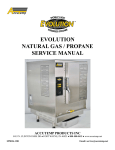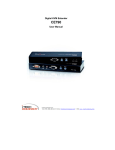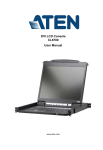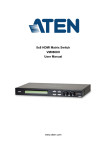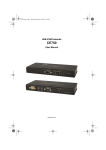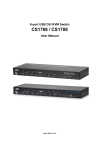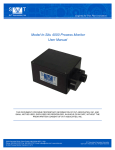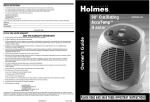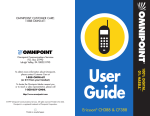Download EVOLUTION ELECTRIC SERVICE MANUAL
Transcript
EVOLUTION ELECTRIC SERVICE MANUAL ACCUTEMP PRODUCTS INC 8415 N. CLINTON PARK DR ● FORT WAYNE, IN 46825 ● 800 480-0415 ● www.accutemp.net SP8027-1203 Email: [email protected] IMPORTANT FOR YOUR SAFETY The Safety Instructions listed on this page below, should be posted in a prominent location as a reminder of safe practices; as well as, recommended actions to follow in the event of an equipment or facility’s utility issue. WARNING In the event of a Power Failure, DO NOT attempt to operate this appliance. WARNING DO NOT store or use Gasoline, or any other Flammable Vapor and/or Liquids in the vicinity of this or any other appliance. WARNING IMPROPER installation, adjustment, alteration, service, or maintenance can cause personal injury or death; and/or property damage. Read the installation, operation, and service/maintenance instructions thoroughly; before installing or servicing this equipment. WARNING Only QUALIFIED service technicians/electricians should perform the equipment installation, to ensure that all electrical and safety requirements are met; and that all wiring is performed in accordance with all national, state, and local electrical codes. SP8027-1203 i WARNING SYMBOL DEFINITIONS SYMBOL DEFINITIONS Symbols are used to attract your attention to possible dangers. They are only effective if the operator uses proper accident prevention measures. Some of the symbols are boxed text; while others maybe just picture icons. Please give this information the respect they deserve for safe operation. Warning Text Boxes Below are definitions of the warning text boxes. DANGER Indicates an imminently hazardous situation; which, if unchanged, will result in death or serious injury. WARNING Indicates a potentially hazardous situation; which, if unchanged, will result in death or serious injury. CAUTION Indicates a potentially hazardous situation; which, if unchanged, will result in minor or moderate injury. NOTE Advises the reader of information or instructions, vital to the operation or maintenance of the equipment. SP8027-1203 Symbol Icons Below are definitions of the symbol icons used in this manual. ALERT Notifies the reader of an important message or warning; usually a safety related message. INFORMATION Notifies the reader of an important information that may or may not be safety related. CAUTION HOT SURFACE DANGEROUS VOLTAGE EARTH GROUND ii SAFETY PRECAUTIONS DANGER ELECTRICAL SHOCK HAZARD WHILE WORKING ON ENERGIZED EQUIPMENT. Unplug equipment prior to removing any components effected by electricity. BURN HAZARD WHILE WORKING ON STEAM PRODUCING EQUIPMENT. When accessing the cooking chamber, be sure to always stand back while slowing opening the door to allow the chamber to vent off the steam. Never reach into the cooking chamber before it has completely vented off the steam. Never reach into the cooking chamber or handle hot items without wearing the proper heat protective gloves. Steam coming out of the holes on the right side of the cooking chamber is invisible and can cause severe burns. Water inside the steam chamber, creating steam, has a temperature of 212°F and will cause burns if touched or spilled on the skin. PERSONNEL INJURY HAZARD WHILE PICKING UP OR MOVING HEAVY EQUIPMENT. Always use 2 people and proper lifting techniques when picking-up, moving, or flipping-over heavy equipment. SLIP & FALL HAZARD WHILE WORKING ON WATER HOLDING EQUIPMENT. Keep the floor in front of the equipment clean and dry. If spills occur, clean them up immediately to avoid potential injuries. SP8027-1203 iii WARNING & CAUTION NOTES WARNING ONLY QUALIFIED SERVICE TECHNICIANS SHOULD PERFORM MAINTENANCE ON THIS EQUIPMENT. CAUTION • DO NOT use abrasive materials, such as wire brushes or metal scouring pads to clean the Water Sensors. • DO NOT use Aluminum Oxide Sandpaper to clean the Water Sensors. It leaves a residue that will not allow Water Sensors to work properly. • DO NOT manually fill water above the Water Level Mark on the left side of steam chamber above the High Limit Level Sensor. SP8027-1203 iv TABLE OF CONTENTS SAFETY Important For Your Safety.......................................................................................................................................i Warning Symbol Definitions..................................................................................................................................ii Safety Precautions................................................................................................................................................iii Warning & Caution Notes.....................................................................................................................................iv T.O.C. & MANUAL HISTORY Table of Contents...............................................................................................................................................v-vi Revision Sheet........................................................................................................................................................1 NOTES Troubleshooting Notes...........................................................................................................................................2 OPERATIONAL & COMPONENT INFORMATION Purpose Reference of Main Component Chart...................................................................................................3-5 Additional Component Part Numbers....................................................................................................................5 Sequence of Operation........................................................................................................................................6-7 Modifying Control/Keypad Program Settings.......................................................................................................8 TROUBLESHOOTING Troubleshooting Flow-Diagram.............................................................................................................................9 Flow-Diagram Reference Troubleshooting Chart..........................................................................................10-12 COMPONENT REMOVAL & INSTALLATION Location of Electrical Components Picture Overview.........................................................................................13 Electrical Components Removal & Installation.............................................................................................14-19 Cord & Plug Assembly................................................................................................................14 Fuses............................................................................................................................................14 Contactor..................................................................................................................................... 14 Transformer.................................................................................................................................15 Water Sensor Control Board....................................................................................................... 15 Control Relay #1......................................................................................................................... 15 Water Sensors..............................................................................................................................16 Control/Keypad Board................................................................................................................ 16 Door Switch................................................................................................................................ 17 Chamber Pressure Switch........................................................................................................... 18 Solid State Relay......................................................................................................................... 18 Temperature (RTD) Probe...........................................................................................................19 Overtemp Switch (ThermalLimit SW3)............................[2 PERSONS REQUIRED].............19 SP8027-1203 v TABLE OF CONTENTS COMPONENT REMOVAL & INSTALLATION (CON’T) Location of Cast Heater Picture Overview..........................................................................................................20 Cast Heater Replacement Kit...............................................................................................................................21 Cast Heater Removal & Installation.............................................. [2 PERSONS REQUIRED]....................22-24 Cast Heater Installation Notes & Cautions..........................................................................................................24 Miscellaneous Components Removal & Installation.....................................................................................25-26 Auto-Fill Valve............................................................................................................................ 25 High Water (Overfill) Reed Switch.......................................[2 PERSONS REQUIRED].......... 25 Float Ball (Magnetic)................................................................................................................... 26 Drain Ball-Valve...........................................................................................................................26 Drip Pan....................................................................................................................................... 26 Door Components Removal & Installation....................................................................................................27-29 Door Assembly.............................................................................................................................27 Inner Door Panel.......................................................................................................................... 27 Door Handle Latch Assembly...................................................................................................... 28 Door Hinge...................................................................................................................................28 Door Gasket..................................................................................................................................29 SCHEMATIC & CHARTS Electrical Schematic AT1T-3595 Rev G (208-240V/ 1Φ)...................................................................................30 Electrical Schematic AT1T-3595 Rev G (208-240V/ 3Φ)...................................................................................31 Electrical Schematic AT1T-3595 Rev G (208-240V/ 3Φ/ 17KW)......................................................................32 Electrical Schematic AT1T-3595 Rev G (440-480V/ 3Φ)...................................................................................33 SP8027-1203 vi REVISION SHEET Current Revision: 1203 Date: 3/31/12 Prior Revision: Date: N/A N/A Change: Initial Release. SP8027-1203 Pg 1 TROUBLESHOOTING NOTES TROUBLESHOOTING NOTES If the steamer is not reaching temperature: • Ensure that the steamer is not in the HOLD Mode verses the COOK Mode. The default mode for the steamer, when the PWR button is turned ON, is COOK. So, if the operator presses the Timer Button then the Cook/Hold button; the operator has just placed the steamer in the HOLD Mode and the steamer will not reach 212°F (COOK Mode). • Ensure that the steam vent (located on the back of the steamer) is not blocked or clogged. If the customer has added an extended exhaust pipe, this could increase the chances of vent blockage, if the exhaust pipe is not installed properly. The exhaust pipe should be made of copper, galvanized or stainless steel. The exhaust pipe should have a diameter of 3/4”; and be sloped 1/4” for every 12” of length (recommend a height no greater than 24”). Also, the addition of extra fittings that can alter the gravitational flow of the steam condensation, can cause blockage. If vent blockage does occur, it will cause the chamber pressure switch to stay open; which prevents the heater from turning back on; and the temperature will continue to drop. Blocked vent can additionally cause steam to blow out of the door. Auto-Fill Steamer: If the steamer is overfilling with water and causing the steamer to shut-off: • Ensure the steamer is level, front to back and side to side. An un-level steamer can cause the water in the steam chamber to collect in the front of the steamer, causing the Over-Fill Float Ball to raise and trip the Reed Switch prematurely (every time the steamer is turned ON). Once the Reed Switch trips, it will cause an Over-Fill Light and Buzzer; while turning off the steamer and preventing its usage. • Ensure that both of the Water Sensors are clean. Build-up of scale or crud will prevent the Water Sensors from providing the appropriate control signals to the Auto-Fill Valve, causing it to overfill with water. • Ensure that the water pressure being supplied to the Auto-Fill Valve should not be greater than 60 psi. If water pressure is to high, then a larger volume of water will be added to the steam chamber during the auto-fill cycle; causing the steamer to overfill with water. SP8027-1203 Pg 2 PURPOSE REFERENCE OF MAIN COMPONENTS Component Contactor (3 Pole) Transformer Overtemp Switch (Thermal Limit SW3) Part # Purpose • Provides line voltage to the Solid State Relay(s), when the contactor’s AT0E-1587-4 coil is closed by the control signal sent from the Water Control Board. • Provides line voltage to the Transformer. AT0E-2662-5 • Steps-down the Supply Line Voltage to 24 -28VAC. • Normally closed switch that provides a safety feature to the machine in case the Cast Heater overheats. AT1E-2653-3 • If the Cast Heater overheats, the switch will open and turn the steamer off; while lighting the red LED Overtemp Light on the Control Panel. 14KW & Up • The steamer will not turn on until the temperature has dropped AT1E-2653-4 enough to allow the Overtemp Switch to close again. 12KW & Lower Control / Keypad Board • Human interface for steamer operations through push-buttons, operations, & display readouts. • Provides power to the Solid State Relay(s) (24VDC). AT0E-3625-1 • Receives input from the Temperature (RTD) Sensor and displays the water temperature on the LED readout. • Maintains the preset HOLD temperature. Water Sensor Control Board • Receives inputs from Water Sensor Probes and implements corresponding actions for those inputs based on the water level in the AT0E-3230-2 steam chamber. • Controls the Auto-Fill Valve (if installed) and receives inputs that provides actions for the desired water level needs. Water Sensor Probe • Teflon exterior with a stainless steel center that uses the minerals in the water to complete the electrical circuit to the Water Control AT1E-2652-1 Board. • MUST BE CLEAN TO WORK PROPERLY. Low Water Level Probe • Once the Low Water Sensor is satisfied, it will allow the Solid State Relay(s) to activate. • If the water level is below the sensor, the Water Board will activate the Auto-Fill Valve (if installed) filling the unit the water until the High Limit Water Sensor is satisfied. High Limit Water Level Probe • On initial chamber water fill, once the water level reaches and satisfies the Operational Water Sensor, the Water Board will keep the Auto-Fill Valve open for 30 additional seconds.. • After initial chamber water fill, when the water level drops below the sensor’s operational level; the Water Board will open the Auto-Fill Valve for 30 seconds to raise the water level back above the High Limit Water Sensor. • This process will repeat as long as the water level stays above the Low Water Sensor. SP8027-1203 Pg 3 PURPOSE REFERENCE OF MAIN COMPONENTS Component Part # Purpose Auto-Fill Valve (OPTIONAL) • Solenoid Valve that allows water to flow into the steam chamber; that AT1A-3841-1 is controlled automatically by the Water Board based on inputs from the Water Sensor Probes. Water Over-Fill Sensor Switch (OPTIONAL) Reed Switch: • Magnetic Reed Switch is used in conjunction with a Float Ball. If the water rises too high, the switch opens and turns off the steamer. AT0A-3519-2 • When the switch opens, the High Water Overfill LED will light. The Float Ball: user will have to drain the water out and turn the steamer back ON; AT0P-3233-1 otherwise, the steamer will remain shutdown. Control Relay #1 AT0E-2825-5 (AC) Door Switch AT0A-3660-1 • Controls AC Volt input & output signals which provide actions from the Water Sensor Board and Auto-Fill Valve (if installed). • Magnetic Switch used to ensure that the door is closed and latched prior to generating steam • Solid State Relay(s) will not activate if this switch is not closed (Door Open). S#: 34769 & Up • Normally closed switch that allows pressure to build-up inside the AT0E-3617-2 Chamber • Pressure Switch S#: 34768 & Lower • AT1A-3847 Solid State Relay AT0E-2059-3 steam chamber. Opens when the steam chamber pressure reaches 1/2 PSI. Solid State Relay(S) will not activate if this switch is not closed (Switch Open). • Provides line voltage to the Cast Heater elements, once the Controller /Keypad Board sends the 24V control signal to the relay(s). • The relay(s) are only activated if the Door Switch & Chamber Pressure Switch are closed. • The number of Solid State Relays used, depends on the phase and wattage needs of the unit. 6 KW: AT1A-3530-1 8 KW: AT1A-3530-2 Cast Heater Replacement Kit • 10 KW: AT1A-3530-3 • 12 KW: AT1A-3530-4 • 14 KW: AT1A-3530-6 Transfers the heat, generated from the internal elements; to boil the water to create steam. Cast Heater can be wired to single or 3 phase; and have a parallel, delta, or wye configuration. Cast Heater must be replaced with the same wattage heater as specified in the model number. 17 KW: AT1A-3530-7 SP8027-1203 Pg 4 PURPOSE REFERENCE OF MAIN COMPONENTS Component Part # Purpose Temperature (RTD) Sensor AT0E-3626-1 • Provides temperature input to Control/Keypad Board, which displays the temperature in the steam chamber based on resistance changes from the Temperature (RTD) Sensor. • Used to maintain the preset HOLD mode temperature. Door Assembly AT1A-3600-1 • Keeps the steam trapped inside the steam chamber to allow pressure to build and cycle the Chamber Pressure Switch. Drain Valve AT1P-2239-1 • Manually Open/Close valve used to drain water from the steam chamber. ADDITIONAL COMPONENT PART NUMBERS Component Part # Component Part # Pilot Lamp, 24V Red AT0E-1800-2 Door Hinge (Pair) AT1H-2058-3 Fuse, 1.25A 250V AT0E-2731-2 Door Latch Assy, Ceramic Magnet AT1H-3609-1 Gasket, Door AT1G-2633-1 Door Latch Mounting Plate AT1M-3046-1 Inner Door Assembly AT1A-3647-1 SP8027-1203 Pg 5 SEQUENCE OF OPERATION INDICATORS AND WATER CONTROL BOARD OPERATION (Manual & Auto-Fill): PWR Button Pushed & Water Level Is Below the Low Water Level Sensor - AUTO-FILL • The Low Water Light Indicator will be lit. • PRE is displayed on the Control/Keypad Board. • The Water Sensor Board sends a signal to the Water Sensor Board’s K1 Relay to open the Auto-Fill Valve and start filling the steam chamber with water. • (The red LED light on the Water Sensor Board will be flashing continuously.) PWR Button Pushed & Water Level Is Below the Low Water Level Sensor - MANUAL FILL • The Low Water Light Indicator will be ON and Alarm will sound. • PRE is displayed on the Control/Keypad Board. • (The red LED light on the Water Sensor Board will be flashing continuously.) PWR Button Pushed & Low Water Level Sensor Is Satisfied - MANUAL & AUTO-FILL • The Low Water Light Indicator and Alarm (only manual fill units use an alarm for low water condition), will be OFF. • This is minimum water level needed for the Contactor to close and turn the Cast Heater ON. • (The red LED light on the Water Sensor Board will have about a 1 second flash delay.) Water Level Is At the High Limit Water Level Sensor - AUTO-FILL • When the water level in the chamber touches the High Water Limit Probe, the Water Sensor Board will continue to activate the Auto-Fill Valve for an additional 30 seconds; and then turns the valve off. (This will occur every time the water level falls below the High Limit Probe.) • (The red LED light on the Water Sensor Board will have about a 2 second flash delay.) Water Level Is Filled Too High in the Steam Chamber - AUTO-FILL • The Float Ball rises on the Over-Fill Reed Switch sensor peg until the magnetic field from the Float Ball is above the Reed Switch, causing the Reed Switch to open. This causes the Control Relay #1 AC coil’s voltage to drop, dis-engaging the relay from the steamer’s normal operation; illuminating the High Water (Over-Fill) Indicator Lamp and sounding the buzzer. • The loss of Control Relay #1 will remove the power signal to the Contactor’s control coil, which opens the contacts and prevents Line Voltage to the Solid State Relay(s). This stops the Cast Heater from generating heat. • (To restart the steamer, open the Drain Valve to drain the water, until the High Water (OverFill) Indicator Light goes out. Press the PWR button ON to restart the start-up procedure.) SP8027-1203 Pg 6 SEQUENCE OF OPERATION CAST HEATER GENERATING HEAT OPERATION (Manual & Auto-Fill): Power Cord Plugged-In & PWR Button Not Pushed • Line Voltage comes into the 3 Pole Contactor’s L1 - L3 terminals. (Refer to the unit’s specific wiring schematics to determine the wire color to “L” Terminal location.) • Line Voltage is then taken off of L1 & L2 of the Contactor and applied to the Transformer, which steps-down the Line Voltage to 24VAC. • From the two, 1.25Amp, fuses; power goes through the Overtemp Switch, then goes to the Water Sensor Board, to Control Relay #1 (CR#1) coil, to the High Water Overfill Reed Switch (Auto-Fill Only), to the Control/Keypad Board, and to Pin 6 of CR#1. Power also flows through CR#1, Control/Keypad Board, Water Sensor Board and Contactor (once the water level condition is met). • (The red LED light on the Water Sensor Board will be flashing continuously.) PWR Button Pushed & Low Water Level Sensor Is Satisfied • (The red LED light on the Water Sensor Board will have about a 1 second flash rate.) • The Water Sensor Control Board’s K2 Relay will close, sending power to the Contactor’s coil; closing the contacts and allowing Line Voltage to be sent to the normally open Solid State Relay(s). • The Control/Keypad Board will send a 24VAC signal to the Solid State Relay(s); closing the Relay(s) (as long as the Door Switch and the Chamber Pressure Switch are closed). • The Solid State Relay(s) then pass Line Voltage to the Cast Heater’s Elements generating heat evenly over the bottom of the steam chamber; creating steam for cooking. Temperature Sensor (RTD) and Control/Keypad Board • As the water temperature rises, the RTD will provide a signal, based on the resistance of the sensor, to the Control/Keypad Board to provide a digital temperature display. • Control Panel will show PRE (Preheat) on initial start-up until the steam chamber reaches 195°F, then COO (Cook) will be displayed between 195°F and 212°F. • The operating default mode on initial PWR ON is COOK mode; which automatically causes the steamer to go to the normal operating boiling point, which is 212°F at sea level. • In COOK mode, the 24VAC output from the Control/Keypad Board is continuously on, so that the unit’s temperature is controlled by the Chamber Pressure Switch, which opens at 1/2 inches of water column or higher. • In HOLD mode (HLD), the steamer’s regulated temperature will change to the HOLD temperature’s preset value. The Control/Keypad Board will regulate temperature via the RTD input, based on the current HOLD mode preset value. (This value can be changed using the program function on the Control/Keyboard Control.) SP8027-1203 Pg 7 MODIFYING CONTROL / KEYPAD PROGRAM SETTINGS Hrs/Min/Sec LED Lights UP Arrow S1 S3 COOK/HOLD DOWN Arrow S4 S6 TEMP Display POWER S1 S4 S3 S6 S2 - S5 S2 TIMER Increase Program Item (Will cycle the Hrs/Min/Sec LED light) Decrease Program Item (Will cycle the Hrs/Min/Sec LED light) Increase Program Value (Will change the Digital Readout display) Decrease Program Value (Will change the Digital Readout display) Exit & Save ENTERING PROGRAM MODE: Simultaneously, depress and hold S4 & S6 for minimum of 8 seconds or until the Hrs LED blinks and the display shows a Hold Temp number (default is 180°F). Now the Controller can operate under the Program Function Parameters. Program Mode Function Parameter Table Hrs LED Min LED Sec LED PARAMETER Blink ON OFF OFF ON Blink ON OFF OFF ON OFF ON Blink Blink OFF OFF OFF ON ON Blink Blink HOLD Temp Value = Degree F Default Timer Value = Hours Default Timer Value = Minutes TEMP Probe Offset = Degree F TEMP Probe Offset = Neg/Pos Diff Hysteresis TEMP Regulating Mode Blink Blink ON Blink Blink ON Proportioning BAND TIME Proportioning BAND WIDTH MIN MAX ELECTRIC MIN Temp 0 0 0 NEG = 1 2 On/Off = 0 4 4 MAX Temp 8 59 50 POS = 0 10 PID = 1 10 10 180 0 30 0 0 2 1 10 10 TO RESET CONTROLLER TO FACTORY DEFAULT VALUES, PRESS AND HOLD S4, THEN PRESS S5. SP8027-1203 Pg 8 TROUBLESHOOTING FLOW-DIAGRAM START YES POWER ON NO Steamer Plugged-In YES NO SEE A YES Breaker ON NO SEE B YES SEE E Low Water Light Over Temp Light YES SEE F YES SEE G SEE D Ball YES SEE H NO Call AccuTemp Service Float Ball Present YES NO Call AccuTemp Service Call AccuTemp Service SP8027-1203 Temp Low Steam Out The Door Food Over Cooked Food Under Cooked YES Float Ball Installed I YES SEE YES SEE YES SEE YES SEE NO DONE WITH CHART J K L NO High Water (Over-Fill) Light NO SEE NO NO SEE C NO NO NO Check Internal Power Voltages YES Control Panel Error Code STEAMER HEATING YES NO YES Component Voltages Correct NO WARNING LIGHTS SEE Ball M YES Different Problem With Steamer Operations YES Call AccuTemp Service (800) 480-0415 or [email protected] Pg 9 FLOW-DIAGRAM REFERENCE TROUBLESHOOTING CHART REF LETTER A B POSSIBLE CAUSE Power Cord Disconnected Breaker Is Tripped Transformer C D E F G H SP8027-1203 EVALUATION Confirm proper voltage is present at receptacle. Plug-in Power Cord. Unplug steamer and check line voltage at plug-in receptacle. Reset Breaker. Check for proper incoming line voltage to the primary side and 24VAC on the secondary side. Fuses Check for blown fuses. Over-Temp Switch Check between the violet wire, terminal J3 on the Water Contrl Board, and the brown wire after the fuse. Control panel not responding. Check for 24VAC incoming power at pins J2-1 & J2-2. Check for output at pins J7-3 & J7-4 (On/Off) = 24VAC Bad Component or Faulty Wiring Check the wiring to the component; including wire-toconnectors, GND’s, and damage. If a component output is bad, then it may need replaced. Error Code: -1F or -99F for Temperature (RTD) Probe. Check for 1000 ohms (at room temp) on Control/Kepad Board on J3 - Pins 1 & 2. EC: -1F = Open Temp (RTD) sensor EC: -99F = Shorted Temp (RTD) sensor Low Water Sensor Not Satisfied Ensure water level is above Low Water Sensor Probe inside the steam chamber. Ensure that the Low Water Sensor is cleaned and that the Water Board is working properly. Steamer Has Over-Heated Check that the water level inside steam chamber is not empty; and refill if needed. If an Auto-Fill unit, then ensure that water supply is not shut-off, or Auto-Fill Valve is faulty. Ensure Water Sensors are clean. Too Much Water In Steam Chamber DO NOT OPEN DOOR! Open Drain Valve until the High Water Light goes off. If light DOES NOT go out and no water in steamer, then possibly a sensor fault. Operational Water Level Sensor Faulty Ensure the top Water Sensor is clean. Check that Water Board is working properly. Float Ball & Reed Sensor Faulty Ensure Float Ball is not stuck on the Sensor Post. Ensure Sensor Post & inside of the Float ball are clean. Check continuity of the Reed Switch (Float over sensor creates continuity; the Float off the sensor is open.) Pg 10 FLOW-DIAGRAM REFERENCE TROUBLESHOOTING CHART REF LETTER POSSIBLE CAUSE Control/Keypad Panel Door Switch Not Engaging Chamber Pressure Switch SP8027-1203 Check for 24-30VAC output (J7 Pins 1 & 2). Ensure Door is shut and handle is latched. Check the Door Switch for continuity with Door closed. Check the butt splices and wire connection terminals for good crimps. Switch is normally closed. Check the Chamber Pressure Switch for continuity. Ensure Chamber Pressure Switch is not stuck open. Steam Vent Blocked Steam should be coming out of vent at back of steamer. Check for blockage in the vent, which can cause the Chamber Pressure Switch to open. Ensure that there is at least a minimum of 1/4” slope for every foot added, of extended exhaust piping. Ensure that any extended exhaust piping is made of galvanized or stainless steel, or copper; and a minimum of 3/4” in diameter. If blockage is present, try to pour some hot water down the vent piping to unclog the blockage (may have to blow out the blockage if water doesn’t help). Solid State Relay(s) Check for 24-30 VAC on pins A1 & A2 of each Solid State Relay. (Green LED should be lit.) Ensure that Relay Contacts are closing when receiving the 24-30 VAC from the Control/Keypad Board. Check that proper line voltage is being passed through the Solid State Relay to the Heating Elements. Cast Heater Check that the correct Amps (based on KiloWatts of unit) are being drawn from each Element. Ensure that all the required voltages (based on required phase needs of the unit) are present to each Element. Contactor Check that the Contactor is not open, preventing the line voltage to the Solid State Relay(s). Steam Temperature Is Not At Desired Cook Temperature Check that the Door is closed and no steam is escaping from it. Verify that Low Water indicator light is not lit. Check that steamer is in the COOK mode and NOT in the HOLD mode. Steam Vent Blocked See Ref Letter I. I J EVALUATION Pg 11 FLOW-DIAGRAM REFERENCE TROUBLESHOOTING CHART REF LETTER POSSIBLE CAUSE EVALUATION Door Assembly Check to see if the Door is seating completely around the face of the Steamer. Check that the Door Gasket does not have any cuts, nicks, debris, or discolorations (white or grey). Pressure Switch Check that the Chamber Pressure Switch opens and closes checking the Ohms reading while blowing into its input hose. (Disconnect the hose from the chamber inlet hole.) Steam Vent Blocked See Ref Letter I. Food Cook Time Too Long Ensure that the proper Cook Time is being used. Refer to the Owners Manual for cooking tips if no mechanical reason is found for this symptom. Food Cook Time Not Long Enough See Ref Letter K. Ensure that the steamer is in the COOK mode and not the HOLD mode. (HOLD has a preset temp value that is below that of 212°F.) Check that proper pan placement is being utilized for best cooking conditions. (See Owners Manual) Ensure that the Drain Ball-Valve is shut tightly or possible loss of heating efficiency. Refer to the Owners Manual for cooking tips if no mechanical reason is found for this symptom. K L M NOTE If your symptoms are not listed in the Flow Chart and/or the REF Chart, then additional troubleshooting may be required. If you need additional ideas for troubleshooting or want to confirm your symptoms with one of our Service Techs, please contact us by phone or e-mail listed below with the unit’s S/N or Model information. AccuTemp Service Dept. Phone AccuTemp Service Dept. Email SP8027-1203 (800) 480-0415 [email protected] Pg 12 LOCATION OF ELECTRICAL COMPONENTS Solid State Relays & Heat Sinks Control/ Keypad Board Chamber Pressure Switch Power Cord Transformer SP8027-1203 Heater/PWR Terminal Strip Contactor Fuses Water Sensor Control Board Water Sensors Control Relay #1 Pg 13 ELECTRICAL COMPONENTS REMOVAL & INSTALLATION CORD & PLUG ASSEMBLY 1. Unplug the Unit. 2. Remove the Left-Side Panel by removing the Sheet Metal Screws holding it in place. 3. Disconnect the Power Cord Leads (Black, White, Red, and/or Green) from L1-3 of the Contactor (note the wire color to its location terminal). 4. On the inside of the unit, remove the retaining nut on the threads of the Power Cord Cable Fitting & pullout the Power Cord. 5. Re-install in reverse order. FUSES 1. Unplug the Unit. 2. Remove the Left-Side Panel by removing the Sheet Metal Screws holding it in place. 3. Pry the Fuses out of the Fuse Block with a flat-head screwdriver or fuse puller. 4. Re-install in reverse order. CONTACTOR 1. Unplug the Unit. 2. Remove the Left-Side Panel by removing the Sheet Metal Screws holding it in place. 3. Disconnect the wires (note the wire color to its location terminal). 4. Remove the 2 mounting nuts and then remove the Contactor. 5. Re-install in reverse order. SP8027-1203 Pg 14 ELECTRICAL COMPONENTS REMOVAL & INSTALLATION TRANSFORMER 1. Unplug the Unit. 2. Remove the Left-Side Panel by removing the Sheet Metal Screws holding it in place. 3. Disconnect the wires (note the wire color to its location terminal). 4. Remove the 2 mounting nuts and then remove the Transformer. 5. Re-install in reverse order. WATER SENSOR CONTROL BOARD 1. Unplug the Unit. 2. Remove the Left-Side Panel by removing the Sheet Metal Screws holding it in place. 3. Disconnect the wires (note the wire color to its location terminal). 4. Carefully, push in the locking leg on the 4 plastic posts while pulling the Water Board up off the posts (note the board’s orientation). 5. Remove the Water Board. 6. Re-install in reverse order. CONTROL RELAY #1 1. Unplug the Unit. 2. Remove the Left-Side Panel by removing the Sheet Metal Screws holding it in place. 3. Disconnect the wires (note the wire color to its location terminal). 4. Remove the 2 mounting screws and then remove Control Relay #1. 5. Re-install in reverse order. SP8027-1203 Pg 15 ELECTRICAL COMPONENTS REMOVAL & INSTALLATION WATER SENSORS 1. Unplug the Unit. 2. Remove the Left-Side Panel by removing the Sheet Metal Screws holding it in place. 3. Open the door and ensure that all the water is drained from the steam chamber. 4. Disconnect the wire from the backside of the Water Sensor (access via left-side panel). 5. Remove the retaining nut that mounts the Water Sensor to the Steam Chamber. 6. Push the Water Sensor through the hole in the steam chamber from the backside. 7. Re-install in reverse order. Torque Sensor Nuts to between 12-15 In-Lbs. CONTROL / KEYPAD BOARD 1. Unplug the Unit. 2. Remove the Left-Side Panel by removing the Sheet Metal Screws holding it in place. 3. Disconnect the wires (note the wire color to its location terminal). 4. Remove the 7 mounting nuts and then remove the Control Panel CCA. 5. (If accessing the Program Mode is needed, go to page 8 for more details.) 6. Re-install in reverse order. SP8027-1203 Pg 16 ELECTRICAL COMPONENTS REMOVAL & INSTALLATION DOOR SWITCH Door Latch on the Left-Hand Side 1. Unplug the Unit. 2. Remove the Left-Side Panel by removing the Sheet Metal Screws holding it in place. 3. Disconnect the probe wires: Control/Keypad Panel J7 Pin 1 & the White/Brown wire from the Chamber Pressure Switch (the wires to the location pins are enter-changeable). 4. Push back the insulation, so you can access the other mounting nut to be removed. 5. Remove the 2 mounting nuts and then remove the Door Switch. Fg 1 6. Re-install in reverse order. Fg 1 Fg 2 Door Latch on the Right-Hand Side 1. Unplug the Unit. 2. Remove the Left-Side, Right-Side, and Top Panel by removing the Sheet Metal Screws holding it in place. 3. Disconnect the probe wires: Control/Keypad Panel J7 Pin 1 & the White/Brown wire from the Chamber Pressure Switch; and pull the wires up, over the top of the steamer (the wires to the location pins are enter-changeable). 4. Remove the insulation on the right side, to access the Door Switch to be removed. Fg 2 5. Remove the 2 mounting nuts and then remove the Door Switch. Fg 3 6. Re-install in reverse order. SP8027-1203 Fg 3 Pg 17 ELECTRICAL COMPONENTS REMOVAL & INSTALLATION CHAMBER PRESSURE SWITCH 1. Unplug the Unit & remove the Left-Side Panel by removing the Sheet Metal Screws holding it in place. 2. Disconnect the Wiring Terminals from the Chamber Pressure Switch (note the wire color to its location terminal). 3. Remove the hose clamp and disconnect the hose from the Chamber Pressure Switch. 4. Remove the 2 mounting nuts holding the Chamber Pressure Switch to chamber cavity. 5. Remove the Chamber Pressure Switch 6. Re-install in reverse order. SOLID STATE RELAY (SSR) 1. Unplug the Unit. 2. Remove the Left-Side Panel by removing the Sheet Metal Screws holding it in place. 3. Disconnect the wires for the desired SSR being replaced (note the wire color to its location terminal). 4. Remove the thread-cover nuts on the back of the steamer, while removing the 2 mounting bolts holding the SSR Assy to the inside-back of the component chamber; and then remove the desired Solid State Relay. 5. Re-install in reverse order. SP8027-1203 Pg 18 ELECTRICAL COMPONENTS REMOVAL & INSTALLATION TEMPERATURE (RTD) SENSOR 1. Unplug the Unit. 2. Remove the Left-Side, Right-Side, and Top Panel by removing the Sheet Metal Screws holding it in place. 3. Disconnect the probe wires from the Control/ Keypad Panel and pull them from the left, over the top, to the steamer’s right-side (the wires to the location pins are enter-changeable). 4. Remove the mounting nut and then remove the Temperature (RTD) Sensor. 5. Re-install in reverse order. Ensure Thermal Paste is applied to the Temperature (RTD) Sensor. OVERTEMP SWITCH (THERM LIMIT SW3) 1. Unplug the unit. 2. Using an additional person, turn the unit upside-down and remove its legs. (Unbolt unit from stand and then turn unit upside-down if applicable.) 3. Remove Left-Side Panel & Bottom CoverPanel by removing the Sheet Metal Screws holding it in place. (Remove Drain Pan Rails if applicable.) 4. Remove the Insulation as needed to provide access to remove the Overtemp Switch from the bottom of the Cast Heater. (Note the insulation location for proper fitting when re-installed.) 5. Disconnect the wires to the Overtemp Switch (note the wire color to the location pin). 6. Unscrew the Overtemp Switch, and remove it from the bottom of the Cast Heater. 7. Re-install in reverse order. Ensure Thermal Paste is applied to the Overtemp Switch and its threading. SP8027-1203 Pg 19 LOCATION OF CAST HEATER Cast Heater SP8027-1203 Pg 20 CAST HEATER REMOVAL & INSTALLATION NOTE The 1/4-20# Nut Special Locking Nut, Can Only Be Used Once. Ensure That A New Cast Heater Replacement Kit Is Ordered and Received; Prior to Removing or Installing the Cast Heater. Part #: AT1A-3530-X * (See Page 4) * Order the Cast Heater Replacement Kit for the Correct Heater Wattage Required. Thermal Paste Overtemp Switch Paint Brush 1/4-20# Locking Nuts SP8027-1203 Cast Heater Installation Instructions Pg 21 CAST HEATER REMOVAL & INSTALLATION REMEMBER: • AN ADDITIONAL PERSON IS REQUIRED, WHEN CONDUCTING MAINTENANCE INVOLVING TURNING THE UNIT OVER. • IF HEATER WIRES HAVE NON-BRAIDED INSULATION, THE HEATER IS NOT A CAST HEATER. CONTACT ACCUTEMP SERVICE AT 800-480-0415. • USE THE INCLUDED CAST HEATER REPLACEMENT KIT INSTRUCTION BOOKLET IN CONJUNCTION WITH THE REMOVAL & INSTALLATION PROCEDURES IN THIS MANUAL. CAST HEATER 1. Unplug the unit and drain all the water out of the steamer. 2. Remove Left-Side by removing the Sheet Metal Screws holding it in place. 3. Disconnect the 6, braided-insulation, Heater Wires from their Terminal Board Connections. (Note the heater wires’ numbers to their location terminals.) 4. Using an additional person, turn the unit upside-down and remove its legs. (Unbolt unit from stand and then turn unit upsidedown if applicable.) 5. Remove the Bottom Cover by removing the Sheet Metal Screws holding it in place. (Remove Drain Pan Rails if applicable.) 6. Remove insulation as needed to access the Cast Heater. (Note the insulation’s location to ensure proper fitting when re-installed.) 7. Disconnect the wires to the Overtemp Switch (note the wire color to its location pin). 8. Unscrew the Overtemp Switch, and remove it from the bottom of the Cast Heater. F-A 9. Remove any insulation and thread lock material from the heater studs using a scouring pad. SP8027-1203 F-F F-A F-E F-B F-D F-C Pg 22 CAST HEATER REMOVAL & INSTALLATION NOTE If Heater Studs are Discovered Broken While Removing the Cast Heater OR If a Heater Stud Breaks-Off While Removing or Installing the Cast Heater Call AccuTemp Service Dept (800) 480-0415. CAST HEATER (CON’T) 10. Using Fig G, loosen all 24 nuts by starting with Nut #24 and working down to #1. 11. Remove all 24; Locking Nuts (F-C), Lock Washers (F-D) & Flat Washers (F-E) from the Cast Heater. (Discard the used Locking Nuts; keep and clean the Lock & Flat Washers.) 12. Remove both Heater Mounting Brackets from the top of the heater by letting them hang, by the wires, over the electrical compartment. F-B 13. Remove the Cast Heater. F-F (Might have to lift heater by its heater wires, or use a flat-head screwdriver to pry up the Cast Heater from the Thermal Compound.) 14. Re-install in reverse order. SEE NEXT PAGE FOR INSTALLATION NOTES. 7 11 9 5 24 16 4 1 13 22 14 2 3 15 6 10 12 8 19 Heater Wires Should Be On Terminal Block Side 18 17 21 23 Front Side Of The Steamer 20 Fig G Only using a brass or stainless-steel brush; scrape, remove, and clean-off any remaining Thread Sealant and Thermal Compound residue from the bottom of the steamer, even around the studs. SP8027-1203 Pg 23 CAST HEATER INSTALLATION NOTES & CAUTIONS NOTE CAST HEATER’S SHINY SIDE FACES THE BOTTOM OF THE STEAMER! Using a Paint Brush, Apply Thermal Paste to the Shiny Side of the Cast Heater. Bellevelle Washers should look like mini-volcanos when placed on heater stud. The HEX Locking Nut Needs to be Torqued Between 23 - 27 IN-LBS. Tighten Starting with Nut #1 and Follow the Numbered Layout Pattern to Nut #24. Tighten Twice in This Pattern. 18 6 10 12 8 20 22 14 2 3 15 23 24 16 4 1 13 21 19 7 11 9 5 17 Notch Cut-Out Goes Towards the Front Side of the Steamer CAUTION DO NOT OVER TORQUE THE LOCKING NUTS. Over Torquing The Zinc Nuts Can Cause the Studs to Break-Off. This Will Cause Heating Issues; and the Steamer Will Not Operate Correctly or Safely. SP8027-1203 Pg 24 MISCELLANEOUS COMPONENTS REMOVAL & INSTALLATION AUTO-FILL VALVE 1. Unplug the Unit & drain any remaining water from the steam chamber. 2. Close the supply water valve and disconnect the Supply Water Hose coming into the steamer. 3. Remove the Left-Side Panel by removing the Sheet Metal Screws holding it in place. 4. Disconnect the wires from the Auto-Fill Valve (note the wire color to its location pin). 5. Disconnect the Auto-Fill Valve Hose Fitting. F-H 6. On the back of the steamer, remove the 4 mounting screws securing the Auto-Fill Valve bracket on the inside of the steamer. 7. Remove the Auto-Fill Valve. 8. Re-install in reverse order. Ensure Sealant is re-applied to all pipe threading. F-H OVER-FILL REED SWITCH 1. Unplug Unit & close the supply water valve. 2. Disconnect the garden hose from the back of the steamer & drain any remaining water from the steam chamber. 3. Remove the Left-Side Panel by removing the Sheet Metal Screws holding it in place. 4. Disconnect the REED Switch wires (note the wire color to its location pin). 5. Turn the unit upside-down and remove its legs. (Unbolt from stand and then turn unit upside-down if applicable.) 6. Remove Bottom Cover by removing the Sheet Metal Screws holding it in place. (Remove Drain Pan Rails if applicable.) 7. Remove the front, insulation pieces that are laying on-top of the Over-Fill Reed Switch. (Wire is ran in-between the insulation pieces.) 8. Remove the retaining nut and lock washer holding the Reed Switch inside the Sensor Post. 9. Remove the High Water Reed Switch. F-I 10.Re-install in reverse order. SP8027-1203 F-I Pg 25 MISCELLANEOUS COMPONENTS REMOVAL & INSTALLATION FLOAT BALL (MAGNETIC) 1. Open the steamer Door and remove the leftside pan rail. 2. Lift and remove the steam collection cover plate. 3. Remove the Float Ball off of the High Water Reed Switch Sensor Post. 4. Re-install in reverse order. Ensure Sensor Post & Float Ball hole are clean before re-installing. DRAIN VALVE 1. Unplug the Unit & drain any remaining water from the steam chamber. 2. Turn the unit upside-down and remove its legs. (Unbolt from stand and then turn unit upside-down if applicable.) 3. Remove Bottom Cover by removing the Sheet Metal Screws holding it in place. (Remove Drain Pan Rails if applicable.) 4. Remove the Drain Handle Cover Plate, and the insulation surrounding the Drain Valve. 5. Remove the Drain Pipe from the Drain Valve. 6. Remove the Drain Valve. 7. Re-install in reverse order. Ensure Sealant is re-applied to all pipe threading. DRIP PAN 1. Unplug the Unit. 2. Remove the 4 Sheet Metal Screws at the bottom of the Front Panel. 3. Slide the Drip Pan(s) out from between the Front Panel and the Bottom Panel. (Ensure the split Drip Pans are sloped towards the center of the steamer.) 4. Re-install in reverse order. SP8027-1203 Drain Cover Plate Split Drip Pan Solid Drip Pan Pg 26 DOOR COMPONENTS REMOVAL & INSTALLATION DOOR ASSEMBLY 1. Unplug the unit and shut the Door. 2. Remove the Hinge Covers. Fig J 3. Remove the 3 hinge screws going into the face of the steamer of the Bottom Hinge. Fig K 4. While supporting the Door on the hinge-side, remove the 3 hinge screws into the face of the steamer of the Top Hinge. 5. Pull the door handle and remove the Door. 6. Re-install in reverse order. Ensure Anti-sieze is re-applied to all hinge screws. Fig K Fig J If the Door Handle Latch Is Moved to the Opposite Side, Ensure That the Door Switch Is Moved to the Corresponding Door Handle Latch Side . Face Screws STEAMER WILL NOT OPERATE IF NOT DONE. INNER-DOOR PANEL 1. Unplug the unit and shut the Door. 2. Remove the Hinge Covers. Fig J 3. Remove the very bottom screw on the door hinge-side of the Bottom Hinge. 4. Remove the very top screw on the door hinge-side of the Top Hinge. 5. Pull the door handle and open the door 6. Lift and pull out the Inner Door Panel. 7. Re-install in reverse order. Ensure Anti-sieze is re-applied to all hinge screws. Inner Door Fig L Fig M Ensure That the Inner Door is Reinstalled with its Middle Brace Bar Behind the Door Latch Tab. Fig L Also, Ensure That the Screw Retainer Openings are Lined-Up with the Door’s Hinge Side. Fig M SP8027-1203 Pg 27 DOOR COMPONENTS REMOVAL & INSTALLATION DOOR HANDLE LATCH ASSEMBLY 1. Unplug the unit & shut the Door. 2. Remove the Hinge Covers. Fig J 3. Remove the very bottom screw on the door hinge-side of the Bottom Hinge & remove the very top screw on the door-side hinge of the Top Hinge. 4. Pull the door handle and open the door 5. Lift and pull out the Inner Door Panel. 6. Remove the 3 mounting nuts and screws, holding the Door Handle Latch to the side of the door, and the Inner Door Holding Tab. 7. Remove the Door Handle Latch Assembly. 8. Re-install in reverse order. Ensure Anti-sieze is re-applied to all hinge screws. DOOR HINGE 1. Unplug the unit & shut the Door. 2. Remove the Hinge Covers. Fig J 3. Remove the 3 hinge screws going into the face of the steamer of the Bottom Hinge. 4. While supporting the Door on the hinge-side, remove the 3 hinge screws into the face of the steamer of the Top Hinge. 5. Pull the door handle and remove the Door. 6. Remove the very bottom screw on the door hinge-side of the Bottom Hinge & remove the very top screw on the door-side hinge of the Top Hinge. 7. Lift and pull out the Inner Door Panel. 8. Remove the remaining door-side screws for the hinge or hinges to be replaced. (Note the orientation of the Hinge Spacer Bars as they relate to the Hinge orientation.) 9. Remove the Door Hinge or Hinges. 10.Re-install in reverse order. Ensure Anti-sieze is re-applied to all hinge screws. SP8027-1203 Ensure That the Inner Door is Reinstalled with its Middle Brace Bar Behind the Door Latch Tab. Fig L Also, Ensure That the Screw Retainer Openings are Lined-Up with the Door’s Hinge Side. Fig M Pg 28 DOOR COMPONENTS REMOVAL & INSTALLATION DOOR GASKET 1. Unplug the unit & shut the Door. 2. Remove the Hinge Covers. Fig J 3. Remove the very bottom screw on the door hinge-side of the Bottom Hinge & remove the very top screw on the door-side hinge of the Top Hinge. 4. Pull the door handle and open the door 5. Lift and pull out the Inner Door Panel. 6. Remove the 6, Gasket retaining brackets by removing the 12 nyloc mounting nuts holding them in place. 7. Remove the Door Gasket. 8. Re-install in reverse order. Ensure Anti-sieze is re-applied to all hinge screws. INSTALLATION NOTE: • Make sure the new Door Gasket is untangled. • Starting at one corner, stretch the Gasket to the opposite corner. • Repeat this sequence until all 4 corners are seated. • Push the Gasket down all the way around to ensure the Gasket seats firmly on the inner door. Gasket Retaining Brackets Gasket Gasket Retaining Bracket Ensure That the Inner Door is Reinstalled with its Middle Brace Bar Behind the Door Latch Tab. Fig L Also, Ensure That the Screw Retainer Openings are Lined-Up with the Door’s Hinge Side. Fig M SP8027-1203 Pg 29 ELECTRIC EVOLUTION WIRING SCHEMATIC (208-240V/ 1Φ) SP8027-1203 Pg 30 ELECTRIC EVOLUTION WIRING SCHEMATIC (208-240V/ 3Φ) SP8027-1203 Pg 31 ELECTRIC EVOLUTION WIRING SCHEMATIC (208V/ 3Φ/ 17KW) SP8027-1203 Pg 32 ELECTRIC EVOLUTION WIRING SCHEMATIC (440-480V/ 3Φ) SP8027-1203 Pg 33








































